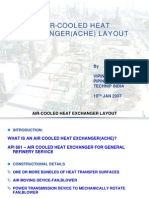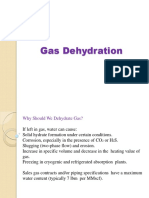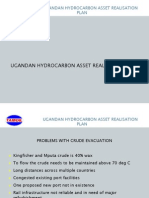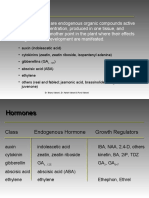Cryogenic Tanks
Cryogenic Tanks
Uploaded by
Rupali Ghodekar GorivaleCopyright:
Available Formats
Cryogenic Tanks
Cryogenic Tanks
Uploaded by
Rupali Ghodekar GorivaleOriginal Title
Copyright
Available Formats
Share this document
Did you find this document useful?
Is this content inappropriate?
Copyright:
Available Formats
Cryogenic Tanks
Cryogenic Tanks
Uploaded by
Rupali Ghodekar GorivaleCopyright:
Available Formats
Cryogenic tanks
Cryogenic tanks are key element to store certain gases, is an essential part for many industries.
Use and utility of cryogenic tanks:
1. Cryogenic tanks are a type of industrial storage tank ideal for situations where large
quantities of gas need to be stored in liquid form.
2. They are the right solution to store substances such as Liquid Oxygen, Liquid Nitrogen,
Argon, C02, LNG, LPG, Liquid Hydrogen, etc., all of which must be stored at very low
temperatures to maintain their properties.
3. As more and more industries require the gases mentioned above, demand for cryogenic
tanks keeps growing and is projected to grow at a higher rate than 5% CAGR between
2020 and 2026.
The main characteristics of an adequate cryogenic storage tank include:
1. They are versatile
2. They provide an optimal internal distribution and thus optimize resources.
3. They allow for the installation of a centralized network for the optimal distribution of the
different cryogenic gases used, so that there is no gas return to the plant.
4. Improved loading process using vaporizers, so that the liquid gas passes directly from the
production plant to the user, avoiding sudden movements and improving stability and
safety.
5. Higher purity than other storage systems, as the gas remains isolated in a hermetically
sealed tank so that the possibility of contamination with any external agents is minimized.
6. Because they’re hermetically sealed, they remain stable and thus are safer than other
storage alternatives.
Types of cryogenic tanks
A. The structure for cryogenic tanks is made of three parts:
1. An inner vessel made of stainless steel and designed to withstand very low temperatures.
2. An outer vessel made of carbon steel.
3. In order to guarantee cryogenic temperatures and safety, these two vessels are insulated
from each other by a combination of materials that provide such insulation.
B. In addition to these two containers, a cryogenic storage tank is also equipped with a pressure
regulation system, which is specifically designed to ensure that the cryogenic tank always
operates at a constant pressure. At the same time, this pressure is set with the user’s needs in
mind.
C. While cryogenic tanks have this basic structure in common, it’s possible to distinguish
between two types of cryogenic container:
1. Flat-bottom cryogenic tanks, such as the flat-bottomed tanks.
2. Large vacuum-insulated cryogenic pressure vessels, such as the new vacuum insulated
vessels
How to choose a cryogenic container?
A. Depending on the substance to be stored
1. When choosing cryogenic tanks, companies must consider what substances they need to
store, and communicate it to the tanks manufacturer.
2. Different substances will require a different tank shape and design, so that it perfectly
adapts to the cryogenic liquid it will need to store.
3. Some common substances that require a cryogenic container include:
LIN (liquid nitrogen)
LOX (Liquid Oxygen)
LAR (Liquid Argon)
CO2 (Carbon Dioxide)
LNG (Liquefied Natural Gas)
LHe (Liquid Helium)
LH2 (Liquid Hydrogen)
LPG ( Liquefied Petroleum Gas)
Liquid Ethylene
B. Depending on the size
Different companies will be in need of different tank sizes, depending on their substance
demand and use, among other factors. At Cryospain we are specialized in tanks for large
quantities >500 m3
C. Depending on the material
Stainless steel and carbon steel are the main two materials for building cryogenic tanks. At
the same time, different insulating materials can be used: from cellular glass, to rockwool and
expanded perlite. Thus, each project must be studied separately, in order to ensure the right
materials are used.
D. Other considerations
Other criteria to pick the right cryogenic tanks can include:
1. The need to comply with national and/or international regulations.
2. The geographical location where the tanks will be installed. For instance, seismic criteria
must be considered. The difficulty to access the are might also present a challenge, like it
did when Cryospain built a flat-bottom cryogenic tank in Santa Cruz, Bolivia.
At Linde, we develop custom large vacuum-insulated cryogenic storage vessels, all according to
our clients’ needs as well as international and local regulations.
We are in charge of designing these cryogenic tanks from the first sketches through to
construction and commissioning, coordinating our design, engineering and production teams.
In order to take into account our clients’ needs and to guarantee a smooth implementation, we
provide a careful design process through computer-aided systems, which provide virtual
simulations of the future cryogenic tanks.
You might also like
- Jeffrey M Wooldridge Solutions Manual and Supplementary Materials For Econometric Analysis of Cross Section and Panel Data 2003Document135 pagesJeffrey M Wooldridge Solutions Manual and Supplementary Materials For Econometric Analysis of Cross Section and Panel Data 2003vanyta020194% (17)
- New Holland Engines F4be0454b F4be0484d F4be0484e F4be0684b Repair ManualDocument20 pagesNew Holland Engines F4be0454b F4be0484d F4be0484e F4be0684b Repair Manualpatricia100% (49)
- LESSON PLAN Elements of WeatherDocument4 pagesLESSON PLAN Elements of WeatherKier Dela CalzadaNo ratings yet
- Lesson Plan For Hair CareDocument2 pagesLesson Plan For Hair Careapi-317363374100% (9)
- The Complete Servicenow System Administrator CourseDocument14 pagesThe Complete Servicenow System Administrator Courseshradha110% (1)
- Use Oracle Visual Builder Add-In For Excel To Create Purchase RequisitionsDocument40 pagesUse Oracle Visual Builder Add-In For Excel To Create Purchase RequisitionsMohmed BadawyNo ratings yet
- Stuvia 416147 History 318 NotesDocument25 pagesStuvia 416147 History 318 NotesCarla BeukesNo ratings yet
- GROUPE 5 Designe Projecte - 3Document55 pagesGROUPE 5 Designe Projecte - 3Abenezer BirhanuNo ratings yet
- Pit Mistry Abhishek ChavanDocument18 pagesPit Mistry Abhishek ChavanAli BaigNo ratings yet
- Low Temperature and Cryogenic Ball ValvesDocument4 pagesLow Temperature and Cryogenic Ball Valves윤병택100% (1)
- Sulzer Sieve Trays PDFDocument20 pagesSulzer Sieve Trays PDFMPilarAlfonsoGonzálezNo ratings yet
- Cryogenic Service Ball ValveDocument2 pagesCryogenic Service Ball ValvesaminasritnNo ratings yet
- Flue-Gas Desulfurization - Wikipedia, The Free EncyclopediaDocument8 pagesFlue-Gas Desulfurization - Wikipedia, The Free EncyclopediaPraveen KhatriNo ratings yet
- All About Cryogenic LNG Storage Tanks and Their DesignsDocument1 pageAll About Cryogenic LNG Storage Tanks and Their DesignsJamesRichards12No ratings yet
- AX5 Vaporizer Electric Water Bath Type LPG VaporizerDocument2 pagesAX5 Vaporizer Electric Water Bath Type LPG VaporizerRicky DermawanNo ratings yet
- Industrial Electric HeatersDocument12 pagesIndustrial Electric Heatersmayukhguha88No ratings yet
- Coal ChemicalDocument71 pagesCoal ChemicalKiran KumarNo ratings yet
- Effluent Treatment Plant: Prepared By-Nishith Shekhar TripathiDocument14 pagesEffluent Treatment Plant: Prepared By-Nishith Shekhar TripathiMgprasanna PrasannaNo ratings yet
- التكسر لاستيل 304 في المبادلاتDocument11 pagesالتكسر لاستيل 304 في المبادلاتFarouq AliNo ratings yet
- OnQuestBroch Training Direct-Fired-Htrs Engineers 3-DayDocument6 pagesOnQuestBroch Training Direct-Fired-Htrs Engineers 3-DayAnonymous bHh1L1100% (1)
- 2022 Aem WeDocument27 pages2022 Aem WepnNo ratings yet
- ABJ PresentationDocument51 pagesABJ PresentationMarvin CastelinoNo ratings yet
- Air Cooler 1Document23 pagesAir Cooler 1Vipin SreekumarNo ratings yet
- Tech. Spec. For Heat ExchangersDocument5 pagesTech. Spec. For Heat Exchangerssanjay421No ratings yet
- Boiler: - IBR Boiler 22.75 Liters in CapacityDocument23 pagesBoiler: - IBR Boiler 22.75 Liters in CapacitySachin ParasharNo ratings yet
- Cryogenic TechnologyDocument12 pagesCryogenic TechnologyALOKSRKNo ratings yet
- Wps PQRDocument7 pagesWps PQRsobariNo ratings yet
- Post Weld Heat TreatmentDocument3 pagesPost Weld Heat TreatmentpvdrameshNo ratings yet
- 2.5 Vol-I, Part-Ii, SCC PDFDocument63 pages2.5 Vol-I, Part-Ii, SCC PDFKoushik DeyNo ratings yet
- Optimum Detailed Design of 13000 m3 Oil Storage TaDocument6 pagesOptimum Detailed Design of 13000 m3 Oil Storage TaHenrikNo ratings yet
- Preparation of Activated Carbon From Rice HuskDocument20 pagesPreparation of Activated Carbon From Rice HuskSabharish MuraliNo ratings yet
- Hot High Pressure SeparatorDocument2 pagesHot High Pressure SeparatorKhai NguyenNo ratings yet
- Why LPG Is Stored in Sphere or Cylindrical BulletDocument1 pageWhy LPG Is Stored in Sphere or Cylindrical BulletBNH Gas TanksNo ratings yet
- Pyrolytic Gasification - Waste Wood For Electricity GenerationDocument84 pagesPyrolytic Gasification - Waste Wood For Electricity Generationk_asiamah2012No ratings yet
- Interview Question and AnswerDocument7 pagesInterview Question and AnswerKalaiYarasanNo ratings yet
- Air Cooled Heat ExchangersDocument6 pagesAir Cooled Heat Exchangersade_sofyanNo ratings yet
- Welding of Pressure VesselsDocument2 pagesWelding of Pressure VesselsDvida PleasureNo ratings yet
- Grasim Industries LimitedDocument12 pagesGrasim Industries LimitedBharat SinghNo ratings yet
- Boiler Life Assessment: L. V. Rama RaoDocument21 pagesBoiler Life Assessment: L. V. Rama RaoArunNo ratings yet
- DeaeratorDocument4 pagesDeaeratorAnonymous NFoZJKYNo ratings yet
- 14-L1-Fluid Bed ReactorsDocument81 pages14-L1-Fluid Bed ReactorsPiyush AgarawalNo ratings yet
- Post Weld Heat TreatmentDocument71 pagesPost Weld Heat TreatmentaamirapiNo ratings yet
- Gas DehydrationDocument9 pagesGas Dehydrationalif forgeNo ratings yet
- Heat ExchangerDocument66 pagesHeat ExchangerKarthik Anandan100% (1)
- Specifications Vol IIDocument154 pagesSpecifications Vol IIPankaj MalpotraNo ratings yet
- Cryogenics and Heat TreatmentDocument25 pagesCryogenics and Heat Treatmentnitesh100% (2)
- 11 Heat Transfer To The Riser Wall of A Circulating Fluidised Bed CFBDocument8 pages11 Heat Transfer To The Riser Wall of A Circulating Fluidised Bed CFBMahesh DasarNo ratings yet
- HPCL STD Spec For Storage TanksDocument16 pagesHPCL STD Spec For Storage TanksnagtummalaNo ratings yet
- Petrochemical UnitDocument1 pagePetrochemical UnitrezamzaNo ratings yet
- W2E-Plastic Pyarolysis Plant Financial ProjectionsDocument15 pagesW2E-Plastic Pyarolysis Plant Financial ProjectionsRaju GummaNo ratings yet
- Boiler Efficiency PresentationDocument13 pagesBoiler Efficiency PresentationAhmad Sabree Abdul BasitNo ratings yet
- TUV India HEATER InspectionDocument21 pagesTUV India HEATER InspectionParthiban NCNo ratings yet
- Introduction To Column InternalsDocument7 pagesIntroduction To Column Internalsamit0% (1)
- Instructed By: Hossein Sadeghi: An Introduction To Welded Tanks For Oil Storage, Api Standard 650Document287 pagesInstructed By: Hossein Sadeghi: An Introduction To Welded Tanks For Oil Storage, Api Standard 650Tania HuqNo ratings yet
- Boiler Efficiency Calculation - A Complete GuideDocument9 pagesBoiler Efficiency Calculation - A Complete GuideShujjat HussainNo ratings yet
- Tri Ethylene GlycolDocument1 pageTri Ethylene Glycolahmar javedNo ratings yet
- Heat Exchanger (New)Document38 pagesHeat Exchanger (New)Rochie DiezNo ratings yet
- Hydrocarbon Processing - Specifying Internals in Sour Water Strippers Part 1 (29dec2020) - 3 Jan 2021Document13 pagesHydrocarbon Processing - Specifying Internals in Sour Water Strippers Part 1 (29dec2020) - 3 Jan 2021achraf ahassanNo ratings yet
- Analytical Assessment of The Mechanical Design of A Metal Getter Bed For Hydrogen StorageDocument15 pagesAnalytical Assessment of The Mechanical Design of A Metal Getter Bed For Hydrogen StorageRupshaBNo ratings yet
- Ugandan Hydrocarbon Asset Realisation PlanDocument15 pagesUgandan Hydrocarbon Asset Realisation PlancenkodaNo ratings yet
- Valve Philosophy Valve Application GeneralDocument3 pagesValve Philosophy Valve Application GeneralWade ColemanNo ratings yet
- 1 Process VesselsDocument4 pages1 Process VesselsARIANA NICOLE RELIGIOSONo ratings yet
- Hydrogen TanksDocument2 pagesHydrogen Tanksaishug.workNo ratings yet
- Cryogenic Gas TankDocument8 pagesCryogenic Gas TankGökçe DunluNo ratings yet
- Tank Storage Design and Selection Resume AssignmentDocument4 pagesTank Storage Design and Selection Resume AssignmentElan Patria NusadiNo ratings yet
- Cryogenic Gas TankkkkkkDocument13 pagesCryogenic Gas TankkkkkkGökçe DunluNo ratings yet
- Tangki MinyakDocument6 pagesTangki MinyakcathlenNo ratings yet
- R.W. - Mens Guide To WomenDocument353 pagesR.W. - Mens Guide To WomenDavid AZ0% (1)
- English Vocabulary Booster: FamilyDocument2 pagesEnglish Vocabulary Booster: FamilyPháp Sư Giấu MặtNo ratings yet
- Drinking Water Methods ProtocolDocument49 pagesDrinking Water Methods ProtocolBalas43No ratings yet
- 2Nd Generation Cpted: An Antidote To The Social Y2K Virus of Urban DesignDocument19 pages2Nd Generation Cpted: An Antidote To The Social Y2K Virus of Urban DesignFábio SalvadorNo ratings yet
- Noise and MusicDocument15 pagesNoise and MusicHaynes BertolNo ratings yet
- Division Memo No. 100 S. 2016 New Guidelines in Accomplishing The Revised School From 5 SF5 and School Form 6 SF6Document6 pagesDivision Memo No. 100 S. 2016 New Guidelines in Accomplishing The Revised School From 5 SF5 and School Form 6 SF6Saldi Xaldz VitorilloNo ratings yet
- Review of Related Literature: Structural CracksDocument18 pagesReview of Related Literature: Structural CracksCunanan, Jade A.No ratings yet
- (Mec.13) PBTMZ4020201Document6 pages(Mec.13) PBTMZ4020201rezaNo ratings yet
- Trans and Genderqueer Subjects in MedievDocument343 pagesTrans and Genderqueer Subjects in Medievazamat SagurNo ratings yet
- Inside Bar Article Colibri TraderDocument23 pagesInside Bar Article Colibri Traderabiel_guerra100% (2)
- Likert Scale PDFDocument2 pagesLikert Scale PDFaxxaan409767% (3)
- Mercantilism - WikipediaDocument5 pagesMercantilism - WikipediaJay VeeNo ratings yet
- Consumer Behaviour Towards Big BazaarDocument87 pagesConsumer Behaviour Towards Big BazaarRahul Pandey71% (28)
- CRISP DM Business Understanding - Data ScienceDocument15 pagesCRISP DM Business Understanding - Data ScienceGanesh V GaonkarNo ratings yet
- 02 ruchiJWoo35-49Document16 pages02 ruchiJWoo35-49Sandeep Kumar JakkarajuNo ratings yet
- Hormones: DR Bhanu Kakrani, Dr. Harish Kakrani & Purvi KakraniDocument55 pagesHormones: DR Bhanu Kakrani, Dr. Harish Kakrani & Purvi Kakraniharishkumar kakraniNo ratings yet
- Reading Comprehension Literal Inferential and Critical Level 2020 PtaDocument4 pagesReading Comprehension Literal Inferential and Critical Level 2020 PtaScribdTranslations100% (1)
- Socket Weld X Threaded Reducer: Welding Gap and Minimum Flat Dimension For Socket Weld FittingsDocument1 pageSocket Weld X Threaded Reducer: Welding Gap and Minimum Flat Dimension For Socket Weld FittingsSefri SusantoNo ratings yet
- Pocket Guide 13Document2 pagesPocket Guide 13ajayi micheal sundayNo ratings yet
- Tooth To Implant ConnectionDocument36 pagesTooth To Implant ConnectionSamuel Flores CalderonNo ratings yet
- ZTC1300V763 1EN技术规格书Document102 pagesZTC1300V763 1EN技术规格书NZ NZNo ratings yet
- Technology Related CAD Issues and Manufacturing IssuesDocument4 pagesTechnology Related CAD Issues and Manufacturing IssuesRajasekar PichaimuthuNo ratings yet
- Course OutlineDocument13 pagesCourse Outlinecats singhNo ratings yet

























































































